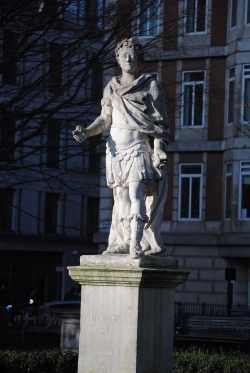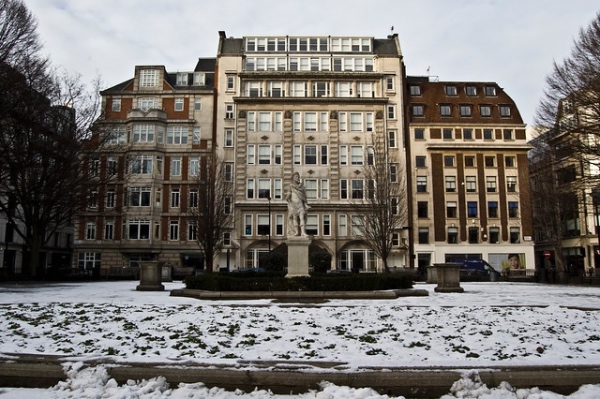This Soho square was laid out in the late 17th century, possibly by Sir Christopher Wren, and by the early 1700s most of the buildings surrounding the square were complete.
The name of the square is said to be a corruption of ‘gelding’ – the area, once apparently known as Gelding Close, was previously used for the grazing of geldings (there’s also a story that the gelding was featured on a nearby inn sign which locals objected to, renaming it ‘golden’).
It was, at first, the place to be among the well-to-do – among early residents were Barbara Villiers, the Duchess of Cleveland and mistress of King Charles II, James Bridges, who became the 1st Duke of Chandos, and Henry St John, 1st Viscount Bolingbroke, a favourite of Queen Anne.
 By the mid 18th century, however, the trendy crowd had moved to developments further west and the square subsequently became noted for the high number of foreign delegations which made their base here, including those of Bavaria, Russia, Genoa and Portugal, as well as foreign artists including Swiss painter Angelica Kauffmann – the first female member of the Royal Academy, and Anglo-Irish painter (and later Royal Academy president) Martin Archer Shee.
By the mid 18th century, however, the trendy crowd had moved to developments further west and the square subsequently became noted for the high number of foreign delegations which made their base here, including those of Bavaria, Russia, Genoa and Portugal, as well as foreign artists including Swiss painter Angelica Kauffmann – the first female member of the Royal Academy, and Anglo-Irish painter (and later Royal Academy president) Martin Archer Shee.
Other famous residents have included dancer Elizabeth Gamberini, singer Caterina Gabrielli and Scottish anatomist John Hunter (his former home is one of two marked with English Heritage Blue Plaques in the square). Thomas Jefferson, later a US president, stayed in Golden Square during March and April, 1786, in his only visit to London.
A couple of houses in the square – then occupied by the Bavarian minister Count Haslang – were attacked during the anti-Catholic Gordon Riots. These properties were bought by James Talbot, the Roman Catholic Bishop for London, in 1788, so the Roman Catholic Church in Warwick Street could be build in the gardens behind.
The square had deteriorated somewhat by the time Charles Dickens placed it in his late 1830s story Nicholas Nickleby as the home of Ralph Nickleby, and it become the location of numerous boarding houses and small hotels as well as various professionals.
By 1900 the square had become closely connected with the wool trade with as many as 70 firms connected with it located here. Several such firms are apparently still located here but the square is better known these days for companies associated with the movie business.
The middle of the square was dug up for an air raid shelter in World War II but it was paved afterwards and the statue of King George II, attributed to John Van Nost and erected here in 1753 as part of beautification project (it has been suggested the statue actually represents King Charles II but that remains a matter of conjecture), returned to its place in the middle.
None of the original houses now remain but there are a number of residences which still have at least elements dating from late 18th century rebuilds including numbers 11, 21, 23 and 24.
PICTURE: Top – David Iliff (licensed under CC BY-SA 3.0); Right – David Adams; Below – RozSheffield (licensed under CC BY-NC-ND 2.0)


One thought on “10 (more) historic London garden squares…2. Golden Square…”